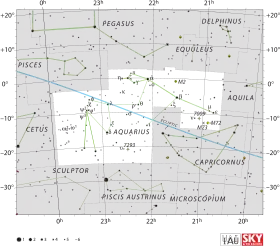Phi Aquarii
Phi Aquarii, Latinized from φ Aquarii, is the Bayer designation for a binary star[8] system in the equatorial constellation of Aquarius. It is visible to the naked eye with a combined apparent visual magnitude of +4.223.[2] Parallax measurements indicate its distance from Earth is roughly 222 light-years (68 parsecs),[1] and it is drifting further away with a radial velocity of +2.5 km/s.[4] It is 1.05 degrees south of the ecliptic so it is subject to lunar occultations.[9]
 | |
| Observation data Epoch J2000 Equinox J2000 | |
|---|---|
| Constellation | Aquarius |
| Right ascension | 23h 14m 19.35965s[1] |
| Declination | –06° 02′ 56.3986″[1] |
| Apparent magnitude (V) | +4.223[2] |
| Characteristics | |
| Spectral type | M1.5 III[3] |
| U−B color index | +1.897[2] |
| B−V color index | +1.563[2] |
| Astrometry | |
| Radial velocity (Rv) | +2.48±0.32[4] km/s |
| Proper motion (μ) | RA: +35.391[1] mas/yr Dec.: –196.862[1] mas/yr |
| Parallax (π) | 14.6670 ± 0.4099 mas[1] |
| Distance | 222 ± 6 ly (68 ± 2 pc) |
| Absolute magnitude (MV) | 0.30±0.120[5] |
| Details | |
| Mass | 1.00±0.03[6] M☉ |
| Radius | 34.77+1.83 −2.04[6] R☉ |
| Luminosity | 207.7±25.2[6] L☉ |
| Surface gravity (log g) | 1.5[4] cgs |
| Temperature | 3715±48[6] K |
| Rotational velocity (v sin i) | 6.7[4] km/s |
| Age | 10.97±0.83[6] Gyr |
| Other designations | |
| Database references | |
| SIMBAD | data |
This is a spectroscopic binary star system with an estimated period of 2,500 days.[10] The primary component is a red giant star with a stellar classification of M1.5 III.[3] The outer envelope of this evolved star has expanded to 35 times the size of the Sun. The star has the same mass as the Sun.[6] It is radiating 208 times the luminosity of the Sun at an effective temperature of 3,715 K,[6] giving it the reddish hue of an M-type star.[11]
References
- Brown, A. G. A.; et al. (Gaia collaboration) (August 2018). "Gaia Data Release 2: Summary of the contents and survey properties". Astronomy & Astrophysics. 616. A1. arXiv:1804.09365. Bibcode:2018A&A...616A...1G. doi:10.1051/0004-6361/201833051. Gaia DR2 record for this source at VizieR.
- Gutierrez-Moreno, Adelina; et al. (1966), "A System of photometric standards", Publications of the Department of Astronomy University of Chile, Publicaciones Universidad de Chile, Department de Astronomy, 1: 1–17, Bibcode:1966PDAUC...1....1G.
- Morgan, W. W.; Keenan, P. C. (1973), "Spectral Classification", Annual Review of Astronomy and Astrophysics, 11: 29, Bibcode:1973ARA&A..11...29M, doi:10.1146/annurev.aa.11.090173.000333.
- Massarotti, Alessandro; et al. (January 2008), "Rotational and Radial Velocities for a Sample of 761 HIPPARCOS Giants and the Role of Binarity", The Astronomical Journal, 135 (1): 209–231, Bibcode:2008AJ....135..209M, doi:10.1088/0004-6256/135/1/209.
- Park, Sunkyung; et al. (2013), "Wilson-Bappu Effect: Extended to Surface Gravity", The Astronomical Journal, 146 (4): 73, arXiv:1307.0592, Bibcode:2013AJ....146...73P, doi:10.1088/0004-6256/146/4/73, S2CID 119187733.
- Baines, Ellyn K.; et al. (2018). "Fundamental Parameters of 87 Stars from the Navy Precision Optical Interferometer". The Astronomical Journal. 155 (1). 30. arXiv:1712.08109. Bibcode:2018AJ....155...30B. doi:10.3847/1538-3881/aa9d8b. S2CID 119427037.
- "* phi Aqr". SIMBAD. Centre de données astronomiques de Strasbourg. Retrieved 2012-07-05.
- Eggleton, P. P.; Tokovinin, A. A. (September 2008), "A catalogue of multiplicity among bright stellar systems", Monthly Notices of the Royal Astronomical Society, 389 (2): 869–879, arXiv:0806.2878, Bibcode:2008MNRAS.389..869E, doi:10.1111/j.1365-2966.2008.13596.x, S2CID 14878976.
- White, Nathaniel M.; Feierman, Barry H. (September 1987), "A Catalog of Stellar Angular Diameters Measured by Lunar Occultation", Astronomical Journal, 94: 751, Bibcode:1987AJ.....94..751W, doi:10.1086/114513.
- Famaey, B.; et al. (May 2009), "Spectroscopic binaries among Hipparcos M giants,. I. Data, orbits, and intrinsic variations", Astronomy and Astrophysics, 498 (2): 627–640, arXiv:0901.0934, Bibcode:2009A&A...498..627F, doi:10.1051/0004-6361/200810698, S2CID 18739721.
- "The Colour of Stars", Australia Telescope, Outreach and Education, Commonwealth Scientific and Industrial Research Organisation, December 21, 2004, archived from the original on March 18, 2012, retrieved 2012-07-02.